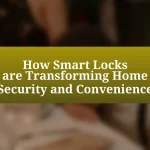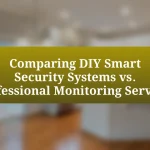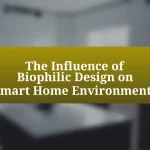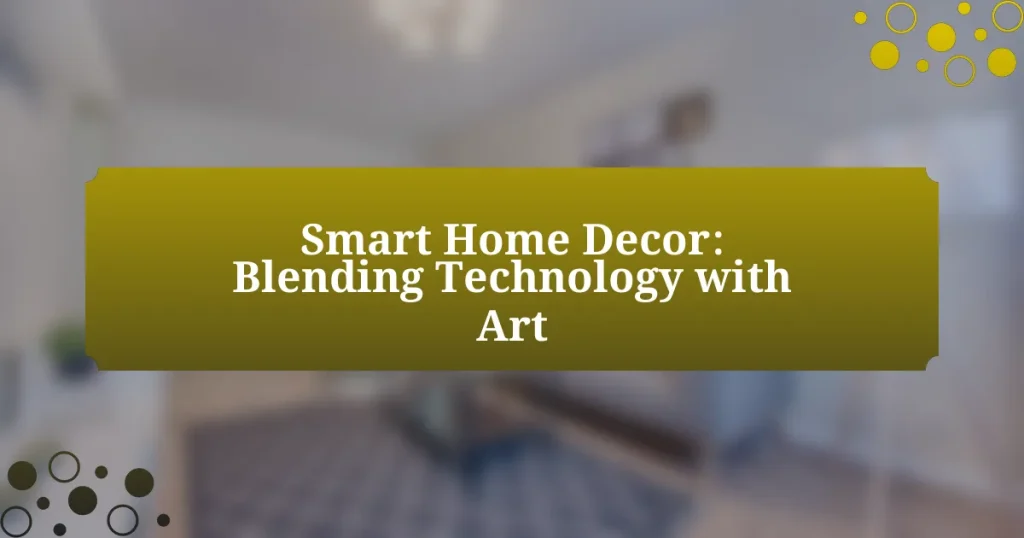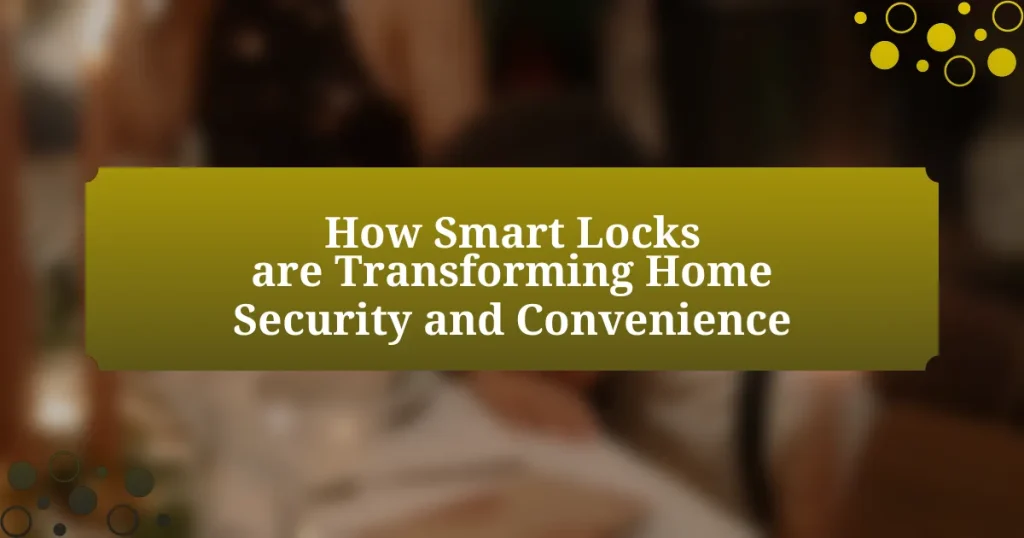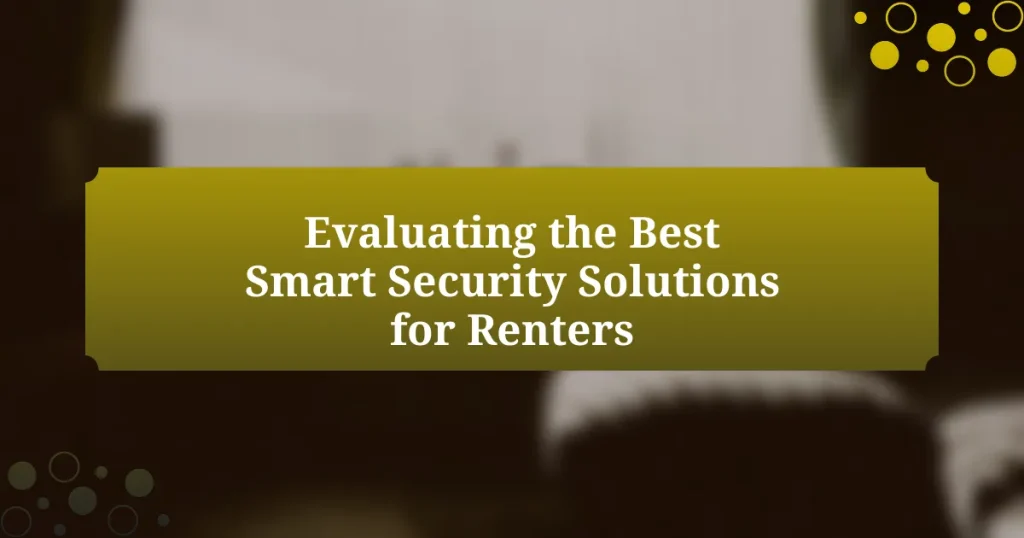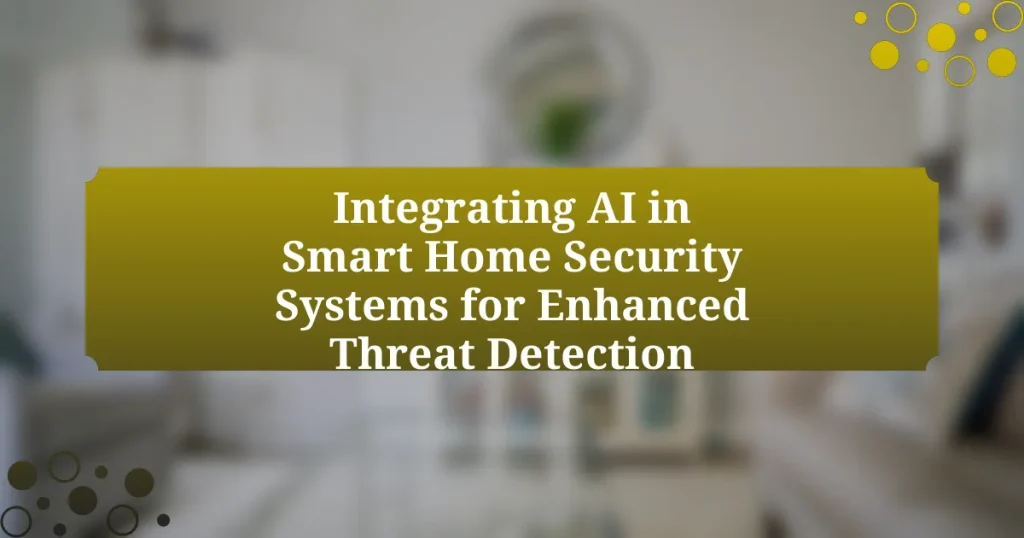Smart Home Decor refers to the integration of technology into home design, enhancing both aesthetics and functionality through devices like smart lighting, thermostats, and security systems. The article explores how technology and art converge in smart decor, highlighting the benefits of convenience, energy efficiency, and personalization. It discusses the types of technology commonly used, the influence of art on design, and the latest trends in smart home decor. Additionally, it addresses challenges in implementation, technical issues, and best practices for maintaining both functionality and aesthetic appeal in smart home environments.
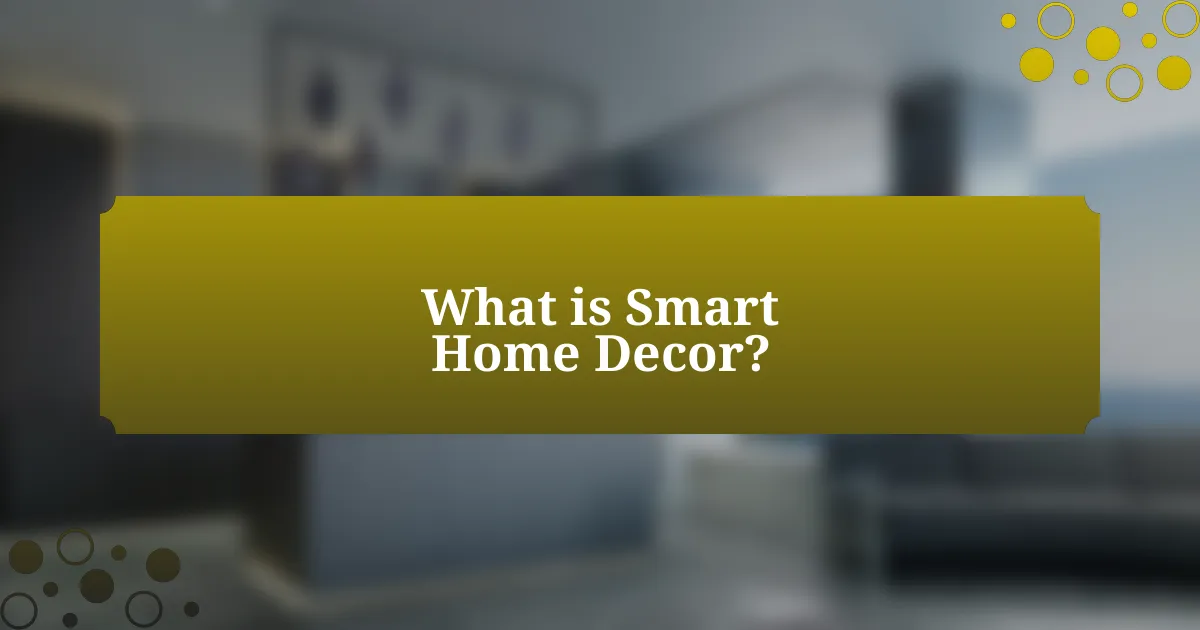
What is Smart Home Decor?
Smart Home Decor refers to the integration of technology into home design and decoration, enhancing both aesthetics and functionality. This concept encompasses smart devices and systems that can be controlled remotely or automated, such as smart lighting, thermostats, and security systems, which seamlessly blend with traditional decor elements. The rise of smart home technology has led to a growing trend where homeowners prioritize both style and convenience, allowing for personalized environments that can adapt to individual preferences and lifestyles.
How does Smart Home Decor integrate technology and art?
Smart Home Decor integrates technology and art by utilizing smart devices that enhance aesthetic appeal while providing functionality. For instance, smart lighting systems can be programmed to change colors and intensities, creating dynamic atmospheres that complement artistic elements in a room. Additionally, digital art frames display rotating artworks, merging traditional art with modern technology, allowing homeowners to personalize their decor effortlessly. This integration is evident in products like Philips Hue lights and Meural Canvas, which exemplify how technology can elevate artistic expression in home environments.
What types of technology are commonly used in Smart Home Decor?
Smart home decor commonly utilizes technologies such as smart lighting, smart thermostats, smart speakers, and smart security systems. Smart lighting systems, like Philips Hue, allow users to control brightness and color through mobile apps or voice commands, enhancing ambiance and energy efficiency. Smart thermostats, such as the Nest Learning Thermostat, optimize heating and cooling based on user habits, contributing to energy savings. Smart speakers, exemplified by Amazon Echo, integrate voice control for music, information, and home automation, creating a seamless user experience. Lastly, smart security systems, including Ring doorbells, provide real-time monitoring and alerts, ensuring safety and peace of mind. These technologies collectively enhance the functionality and aesthetic appeal of home environments.
How does art influence the design of Smart Home Decor?
Art significantly influences the design of Smart Home Decor by integrating aesthetic appeal with technological functionality. This integration allows for the creation of visually pleasing environments that enhance user experience while maintaining the practical benefits of smart technology. For instance, artists and designers often collaborate to produce smart devices that not only serve a purpose, such as lighting or temperature control, but also act as decorative elements, thereby transforming everyday objects into art pieces. Research indicates that homes featuring artful designs can improve mood and well-being, demonstrating that the aesthetic quality of smart decor can have a positive psychological impact on residents.
What are the key benefits of Smart Home Decor?
The key benefits of Smart Home Decor include enhanced convenience, improved energy efficiency, and increased personalization. Smart Home Decor allows users to control lighting, temperature, and security systems remotely, making daily routines more efficient. For instance, smart lighting can be programmed to adjust automatically based on the time of day, which not only saves energy but also creates a comfortable living environment. Additionally, smart decor items can be customized to reflect individual tastes and preferences, allowing for a unique aesthetic that aligns with the homeowner’s style. These benefits are supported by market research indicating that smart home technology can reduce energy consumption by up to 30%, demonstrating its effectiveness in promoting sustainability while enhancing user experience.
How does Smart Home Decor enhance the living experience?
Smart Home Decor enhances the living experience by integrating technology with aesthetic design, creating a more functional and personalized environment. This integration allows for automation of lighting, temperature, and security, which can be controlled remotely or through voice commands, leading to increased convenience and comfort. For instance, studies show that smart lighting can improve mood and productivity by adjusting brightness and color temperature according to the time of day. Additionally, smart decor items, such as digital art frames, can display a rotating selection of artwork, allowing homeowners to customize their space easily and keep it fresh. This blend of technology and art not only elevates the visual appeal of a home but also enhances the overall quality of life for its inhabitants.
What impact does Smart Home Decor have on energy efficiency?
Smart Home Decor significantly enhances energy efficiency by integrating technology that optimizes energy consumption. Smart devices, such as programmable thermostats and energy-efficient lighting, allow homeowners to monitor and control their energy use in real-time. For instance, a study by the American Council for an Energy-Efficient Economy found that smart thermostats can reduce heating and cooling costs by up to 10-12% annually. Additionally, smart lighting systems can adjust brightness based on natural light availability, further decreasing energy waste. These technologies collectively contribute to lower energy bills and a reduced carbon footprint, demonstrating the positive impact of Smart Home Decor on energy efficiency.
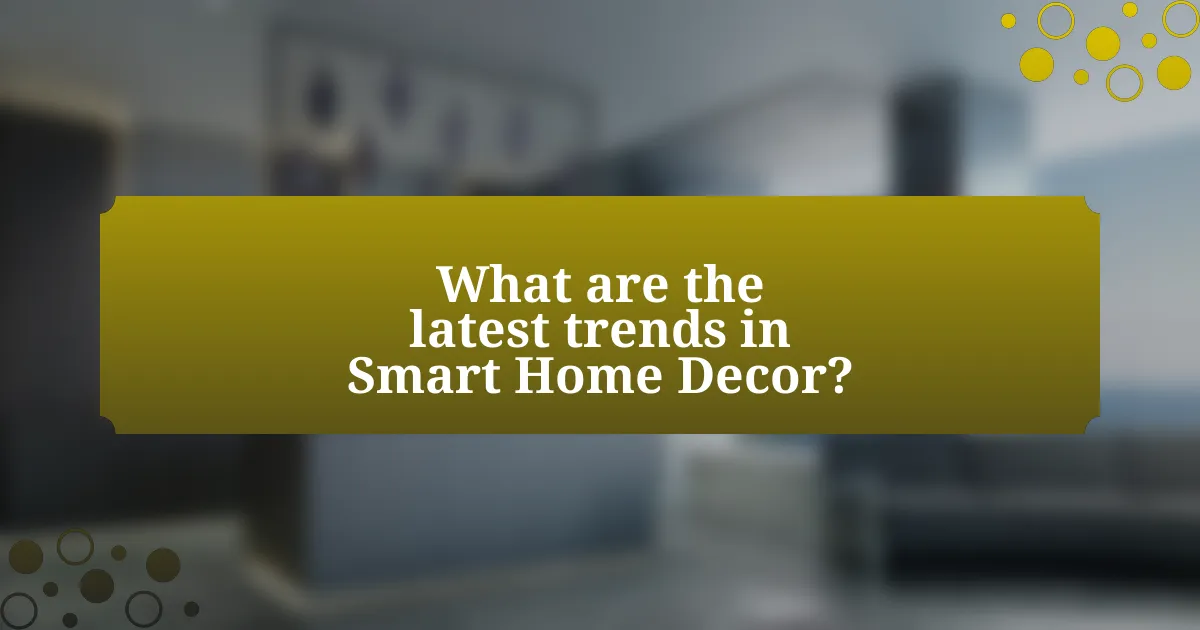
What are the latest trends in Smart Home Decor?
The latest trends in Smart Home Decor include the integration of smart lighting, automated window treatments, and voice-controlled devices. Smart lighting systems, such as Philips Hue, allow users to customize colors and brightness through apps or voice commands, enhancing ambiance and energy efficiency. Automated window treatments, like Lutron’s Serena shades, provide convenience and energy savings by adjusting based on time of day or sunlight. Additionally, voice-controlled devices, exemplified by Amazon Echo and Google Nest, enable seamless control of various smart home elements, creating a cohesive and user-friendly environment. These trends reflect a growing emphasis on convenience, personalization, and energy efficiency in home decor.
How are smart devices changing home aesthetics?
Smart devices are transforming home aesthetics by integrating sleek designs and functionality that enhance modern living spaces. These devices, such as smart speakers, lighting systems, and thermostats, often feature minimalist designs that blend seamlessly with contemporary decor, promoting a clean and uncluttered look. For instance, smart lighting can be adjusted to create various moods and atmospheres, allowing homeowners to customize their environments easily. Additionally, the rise of smart home technology has led to the development of products that prioritize both form and function, such as smart mirrors that display information while serving as traditional mirrors. This shift towards aesthetically pleasing technology not only elevates the visual appeal of homes but also encourages a more cohesive design approach that harmonizes technology with artistic elements.
What role does automation play in modern home decor?
Automation plays a crucial role in modern home decor by enhancing convenience, personalization, and energy efficiency. Smart home systems allow users to control lighting, temperature, and security through automated devices, creating a seamless living environment. For instance, automated lighting can adjust based on the time of day or occupancy, improving both ambiance and energy savings. According to a study by the Consumer Technology Association, 70% of smart home device owners report increased comfort and convenience in their daily lives, demonstrating the significant impact of automation on home decor.
How can personalized art be incorporated into Smart Home Decor?
Personalized art can be incorporated into Smart Home Decor through digital frames that display custom images and artworks, allowing homeowners to easily update their decor. These digital frames can connect to smart home systems, enabling users to curate their art collections remotely via mobile apps or voice commands. For instance, a study by the International Journal of Smart Home Technology highlights that integrating personalized digital art enhances the aesthetic appeal and emotional connection within living spaces, making them more inviting and reflective of individual tastes.
What are the challenges of implementing Smart Home Decor?
The challenges of implementing Smart Home Decor include high initial costs, compatibility issues, and user privacy concerns. High initial costs arise from purchasing smart devices and installation services, which can deter potential users. Compatibility issues occur when different smart devices from various manufacturers do not seamlessly integrate, leading to a fragmented user experience. User privacy concerns stem from the collection of personal data by smart devices, raising fears about data security and unauthorized access. These challenges can hinder the widespread adoption of smart home decor solutions.
What technical issues might arise with Smart Home Decor systems?
Technical issues that might arise with Smart Home Decor systems include connectivity problems, compatibility issues, and security vulnerabilities. Connectivity problems can occur due to weak Wi-Fi signals or interference from other devices, leading to unreliable performance. Compatibility issues may arise when different smart devices from various manufacturers do not work seamlessly together, causing functionality limitations. Security vulnerabilities are a significant concern, as these systems can be targets for cyberattacks, potentially compromising personal data and privacy. According to a report by the Cybersecurity & Infrastructure Security Agency, smart home devices are often inadequately secured, making them susceptible to hacking.
How can homeowners overcome design limitations in Smart Home Decor?
Homeowners can overcome design limitations in Smart Home Decor by integrating modular and customizable smart devices that align with their aesthetic preferences. This approach allows for flexibility in design, enabling homeowners to adapt their decor as technology evolves. For instance, using smart lighting systems that can change colors and intensities can enhance the ambiance without compromising the overall design theme. Additionally, selecting smart furniture that incorporates technology seamlessly, such as coffee tables with built-in charging stations, can maintain a cohesive look while providing functionality. Research indicates that 70% of homeowners prioritize aesthetics when choosing smart home products, highlighting the importance of design compatibility in smart home integration.
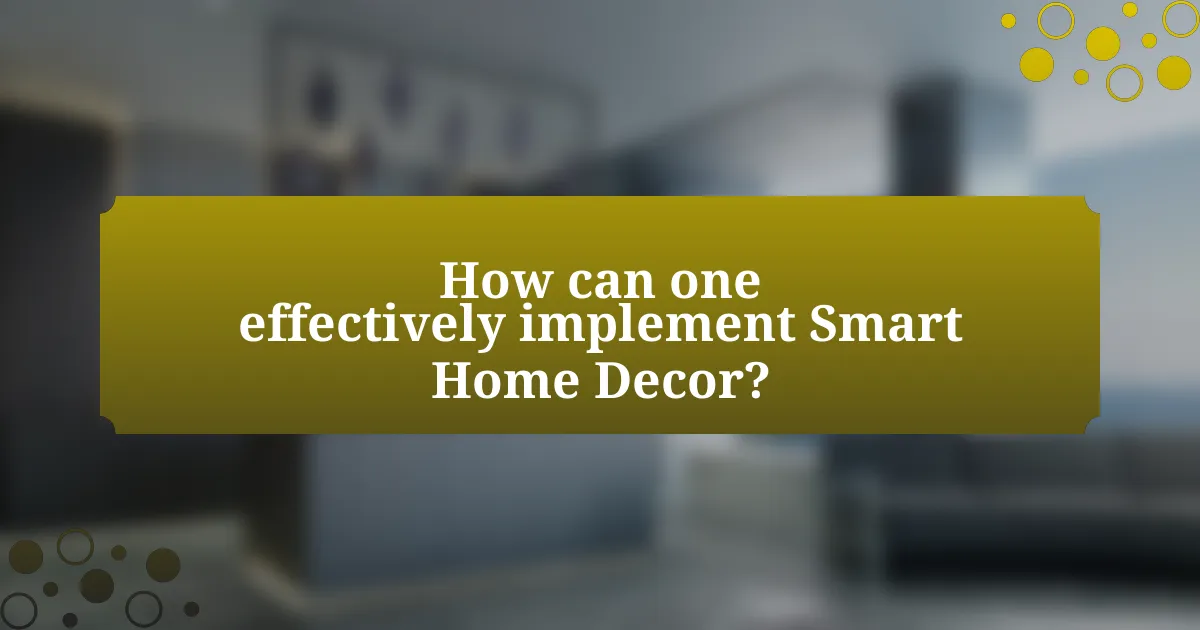
How can one effectively implement Smart Home Decor?
To effectively implement Smart Home Decor, one should integrate smart technology seamlessly with aesthetic design elements. This can be achieved by selecting smart devices that complement the existing decor, such as smart lighting that can change colors to match the mood or smart speakers that blend into the furniture. Research indicates that 70% of homeowners prioritize aesthetics when choosing smart home devices, highlighting the importance of visual appeal alongside functionality. Additionally, utilizing smart home platforms that allow for centralized control of devices enhances user experience and ensures a cohesive design throughout the space.
What steps should be taken to start integrating technology into home decor?
To start integrating technology into home decor, first assess your existing space and identify areas where technology can enhance functionality or aesthetics. This involves evaluating your current decor style and determining how smart devices, such as smart lighting, thermostats, or speakers, can complement it.
Next, select compatible smart devices that align with your decor theme; for example, choose smart bulbs that can change colors to match your room’s ambiance or smart frames that display digital art.
After selecting devices, install them according to manufacturer guidelines, ensuring they are seamlessly integrated into your existing decor without compromising the overall design.
Finally, utilize apps or smart home systems to control these devices, allowing for customization and automation that enhances both convenience and style. Research indicates that 70% of homeowners are interested in smart home technology, reflecting a growing trend towards integrating tech into living spaces.
How can homeowners choose the right smart devices for their space?
Homeowners can choose the right smart devices for their space by assessing their specific needs, compatibility with existing systems, and the overall aesthetic of their home. Identifying the primary functions desired, such as security, energy efficiency, or convenience, helps narrow down options. Compatibility with platforms like Google Home or Amazon Alexa ensures seamless integration. Additionally, selecting devices that complement the home’s decor enhances the visual appeal, as studies show that well-integrated technology can improve user satisfaction and engagement.
What considerations should be made for blending technology with traditional art?
Blending technology with traditional art requires careful consideration of the preservation of artistic integrity and the enhancement of viewer experience. Artists must ensure that the integration of technology does not compromise the original intent and aesthetic of the artwork. For instance, using augmented reality can enhance the viewer’s interaction without altering the physical piece. Additionally, the choice of technology should complement the art form; for example, digital projections can add depth to paintings, while interactive installations can engage audiences in new ways. Research indicates that technology can increase audience engagement by up to 50%, demonstrating its potential to enrich traditional art experiences.
What are some best practices for maintaining Smart Home Decor?
To maintain Smart Home Decor effectively, regularly update software and firmware of smart devices to ensure optimal performance and security. This practice is essential because outdated software can lead to vulnerabilities and malfunctions. Additionally, routinely clean and organize smart devices and their surroundings to prevent dust accumulation, which can interfere with functionality. For instance, smart speakers and cameras should be kept free of obstructions to ensure clear audio and video quality. Finally, integrate a centralized control system to streamline management of all smart devices, enhancing user experience and efficiency.
How can users ensure their smart devices remain functional and secure?
Users can ensure their smart devices remain functional and secure by regularly updating their software and firmware. Keeping devices updated protects against vulnerabilities, as manufacturers often release patches to address security flaws. According to a report by the Cybersecurity & Infrastructure Security Agency, 85% of successful cyberattacks exploit known vulnerabilities, emphasizing the importance of timely updates. Additionally, users should implement strong, unique passwords and enable two-factor authentication, which significantly reduces the risk of unauthorized access. Research from the Ponemon Institute indicates that 60% of data breaches are linked to weak passwords, highlighting the necessity of robust security practices. Regularly reviewing device settings and monitoring network activity also contributes to maintaining functionality and security.
What tips can enhance the aesthetic appeal of Smart Home Decor?
To enhance the aesthetic appeal of Smart Home Decor, focus on integrating technology seamlessly with design elements. Utilizing smart lighting systems, such as Philips Hue, allows for customizable ambiance that complements interior styles. Incorporating smart art displays, like Meural Canvas, can transform digital art into a focal point, merging technology with creativity. Additionally, selecting smart furniture that blends functionality with aesthetics, such as coffee tables with built-in charging ports, can maintain a clean look while providing utility. Research indicates that well-designed smart home elements can increase perceived value and satisfaction in living spaces, reinforcing the importance of aesthetic integration in smart home decor.

